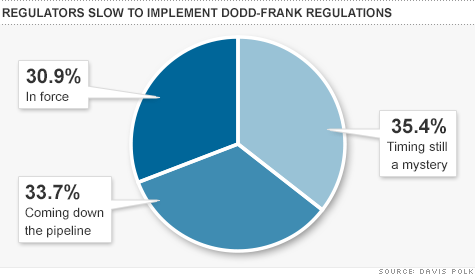
WASHINGTON (CNNMoney) -- Two years after Congress enacted sweeping reforms intended to rein in risky practices on Wall Street, only a third of the new rules are actually in force.
The rest of the so-called Dodd-Frank rules are either stuck in a regulatory bog, ready-to-go but delayed, or substantially weaker than originally envisioned after pressure from financial industry lobbyists, according to data compiled by the law firm Davis Polk.
Former FDIC chief Sheila Bair said the reforms are "drowning in a sea of complexity." Regulators charged with carrying out the rules aren't doing their job in a "muscular enough" way, she added.
Even some top bank CEOs recognize that the regulatory process has been slow after Congress punted many of the more controversial decisions to regulators.
"A lot of Dodd-Frank, as a bill, was skeletal and a lot of the very, very important details were left to the regulatory process," said Lloyd Blankfein, chief executive of Goldman Sachs (GS, Fortune 500), which has spent $15 million lobbying since 2009. "The regulators themselves are having problems coming to the right conclusions and filing those in."
With so much on their shoulders, regulators have been meeting regularly with bank lobbyists, many of whom are experts but also have an agenda to ease or roll back parts of Dodd-Frank.
A recent analysis of public records by the watchdog group the Sunlight Foundation chronicled the number of meetings between regulators and some of the nation's most powerful banks. Goldman Sachs: 181 meetings. JPMorgan Chase (JPM, Fortune 500): 175. And Morgan Stanley (MS, Fortune 500) -- 150.
"All the lobbyists come in and they want this exception or that exception, and [regulators] are accommodating that and they shouldn't," said Bair, who ran the Federal Deposit Insurance Corp. during the financial crisis and its aftermath. "They need to just tell these folks no."
Indeed, securities and investment firms spent more $101 million lobbying regulators last year, according to the Center for Responsive Politics, a nonpartisan research group. That's on top of $103 million spent lobbying lawmakers and regulators in 2010.
Wall Street's representatives say lobbying is not only their right but necessary to ward off unintended consequences that could squelch credit and choke the financial system.
"Congress uses broad strokes. Regulators do the nitty-gritty. These are new rules of the road and the topics they're discussing are complex and inter-related," said Scott Talbott, a senior vice president for government affairs at the Financial Services Roundtable. "Everyone can and should comment to the regulators on how to implement these ideas."
To be sure, some of Dodd-Frank's signature provisions are in play.
The Consumer Financial Protection Bureau -- the first of its kind at the federal level -- is up and running, regulating corners of finance like mortgages that had gone unwatched for years.
And the biggest Wall Street banks are starting to submit so-called living wills, or blueprints of the fastest way to ensure failure of big financial companies without taxpayer bailouts.
But the financial industry has had time to make its mark on Dodd-Frank, which President Obama signed into law on July 21, 2010.
Many rules have been delayed. New regulations requiring larger capital cushions at the big banks, which had been over-leveraged going into the financial crisis, don't start to kick in until January. The safest, thickest capital cushions won't be in place until 2019.
When it comes to shining a light on derivatives, the trades that got insurer American International Group (AIG, Fortune 500) in trouble, new rules will start to kick in later this year.
Thanks to financial industry lobbying, however, those rules will affect a much smaller group of companies that use derivatives than had been originally imagined.
And it's anyone's guess as to when some of the even more controversial regulations will kick in.
Take the proposed Volcker rule, brainchild of former Federal Reserve Chairman Paul Volcker.
The rule was designed to protect the public by curtailing Wall Street banks from making big, risky trades on their own accounts. After two years, a final ban has yet to be released or enforced. Last fall, regulators released more than 300 questions it was grappling with.
One of the main things holding back Dodd-Frank, critics say, is the complexity of the law and the regulations that implement it.
Even the consumer bureau, an agency dedicated to making things simpler, can get mired in complexity. It took nearly 1,100 pages to officially propose a simpler mortgage disclosure form.
"The majority of the proposal text is background information," said consumer bureau spokeswoman Jennifer Howard. "That we have included so much background information is part of our effort to be a responsible and transparent regulator." ![]()
| Overnight Avg Rate | Latest | Change | Last Week |
|---|---|---|---|
| 30 yr fixed | 3.80% | 3.88% | |
| 15 yr fixed | 3.20% | 3.23% | |
| 5/1 ARM | 3.84% | 3.88% | |
| 30 yr refi | 3.82% | 3.93% | |
| 15 yr refi | 3.20% | 3.23% |
Today's featured rates:
| Latest Report | Next Update |
|---|---|
| Home prices | Aug 28 |
| Consumer confidence | Aug 28 |
| GDP | Aug 29 |
| Manufacturing (ISM) | Sept 4 |
| Jobs | Sept 7 |
| Inflation (CPI) | Sept 14 |
| Retail sales | Sept 14 |